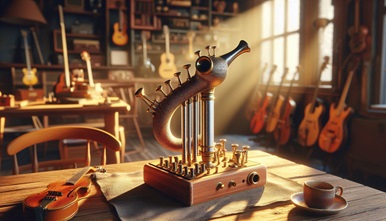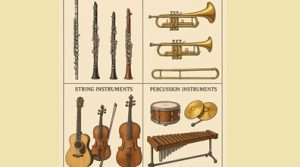What’s the least popular instrument? Underrated & Overlooked
What’s the least popular instrument? Underrated & Overlooked
It is most assuredly about teamwork, and several instruments form a band or orchestra. Each one’s contribution, while distinct and specialized, creates beautiful music in harmony and depth.

While some are nearly household names, others form the foundation quietly but without much fanfare. E.g., in the typical band in a school, it is normal to find a dozen clarinet players-but maybe just one or two on tuba.
Least Popular Instrument
Likewise, orchestras are flooded with violins, but you will rarely see more than a single double bass.
So, let’s take a moment to pay homage to the unsung heroes of music, the underrated instruments that, by some miracle of fate, haven’t ever been placed in the spotlight but are essential.
A Spotlight on the Least Popular Instrument
Tuba: The Gentle Giant of the Brass Family (Least Popular Instrument)
The tuba is the largest, lowest-sounding brass instrument, 30 feet in length if you stretched it out! It plays below the bass clef of the deepest tones in the entire band.
No, it doesn’t get flashy solos, but the tuba is essential for balancing the sound of the rest of the ensemble.
It adds weight to the music and every now and then gets powerful – low-pitched parts that add drama and depth.
Euphonium: The Smooth Operator (Least Popular Instrument)
It has the same range as that of the trombone, with characteristics similar to those of a small tuba.
Unlike the trombone, it does not have a slide, but uses valves. It’s just not as common and tends to stay on the bottom, so people miss it.
But, it’s really rich, the hauntingly beautiful part-just makes for smoothness in any brass section.
Bassoon: The Rare Reed (Least Popular Instrument)
And acts very much like a bass clarinet, a deep-voiced woodwind.
Long, rather complex-looking, and admittedly not the easiest of instruments to master which probably explains why there are not too many taking it up.
Its sound, however, is unmistakable-dark, reedy, and full of expression. Coupled with instruments like the tuba, it stands to add exceptionally powerful richness found at the lower ends of the ensemble.
French Horn: The Mellow Mystery (Least Popular Instrument)
The French horn is unique.
Nothing else sounds like it. It is played with the player’s hand in the bell, and you can get quite a smooth, mellow tone, ranging anywhere from heroic to haunting.
It reads in treble clef and is incredibly versatile. This is one of the reasons, however, that the horn is one of the least popular brass instruments.
Most probably because it is also one of the most difficult brass instruments to play well
Oboe: The Furry Beauty (Least Popular Instrument)
Most certainly sound in the woodwind family, the oboe is forced to gain the attention because it forms with a double reed; thus, the tone is a nasal, slightly buzzy one and surprisingly quite beautiful.
It ranges the same as a flute, but an expressive sound almost always earns it a variety of solo passages, especially in emotional or romantic music.
Nevertheless, quirky tone and difficulty make it less popular, especially for beginners.
Trombone: The Sliding Sound Machine (Least Popular Instrument)
The trombone is one of the most identifiable instruments in a band, yet not as popularly played as the others.
Its main boast? It is the only brass instrument to use a slide, gliding smoothly for notes through what is referred to as a lissando. Most trombones are made as tenor, but alto and bass trombones exist.
The trombone is often relegated to long, low notes, but can also proudly join the ranks of big, brass solos.
Viola: The Misunderstood Middle Voice (Least Popular Instrument)
Among string instruments, the viola is usually the secondary instrument, in most cases, literally. It is guaranteed to be larger than a violin but smaller than an average-sized cello.
Except for dimensions, it fills in the middle register-from deep to the highest regions-providing richness and harmony to an orchestra.
Because it often fails to carry the melody and is somehow mistaken for a “big violin,” it’s often dismissed. This warm, rich, and deep tone, however, is unnecessary, and with good use, the viola can strike a deep chord in anyone.
People don’t like that mixture of sound; they want something high or low,” quotes Ben K, a chamber violist. But it is indeed that middle ground that puts the viola in a unique position.
Double Bass: The Deep Foundation (Least Popular Instrument)
The double bass is the tallest of all string instruments, with a prominent low sound, and is the loudest.
It is not an eye-catching instrument, nor does it usually put its name above the rest of the orchestra, but any thunderous low chord played by it undoubtedly forms the heartbeat of every orchestra.

It is also physically demanding to play, as fingerings are spaced very widely and strings are heavy-but those who can bear it are rewarded-with an experience truly worth the effort, and with a sound that only this instrument can provide.
Every instrument brings something special to the table, even those that do not get much light shed upon them.
If you want something different, then get one of these underappreciated instruments. Who knows, it might be your next musical superpower.
10 Uncommon Musical Instruments from around the world
Be it ornate and baroque or simple and straightforward, here is a status of musical instruments from around the world.
- Ðàn Tre
The ‘bamboo musical instrument’ recognizes the shape of Ðàn Tre-the-two in all the earth, made for himself by Minh Tam Nguyen, a Vietnamese refugee, as a means of expressing creativity in the work camp to which he had been sent.
The other 23 strings are extracted from the inside of a United States Army telephone cable.
Parts of Europe and Asia have been fused in this recycled instrument, made with items available in the camp: a bamboo tube, a four-liter tin of olive oil that amplifies the sound traveling down the tube, and it is made from recycled materials that one finds around the camp: a bamboo tube.
A four-liter tin of olive oil that amplifies the sound traveling down the tube, and 23 strings made from the inside of a United States Army telephone cable.
- Tenor cornett
Known as a lizard because of its snake shape, the tenor cornet was found among all other instruments from the years 1500 to 1650, as they were made from wood pipes with fingerholes along the body, and as playing would become increasingly difficult.
The mouthpiece is more like a brass instrument than a typical woodwind. Most cornetts were used to support the human voice in choirs, especially countertenors, having a range of two-and-a-half octaves.
- Mayuri
The esraj has an exquisite charm that enamoured the Indian courts in the 19th century.
Resembling a sitar with a bowed string neck, played while kneeling, the esraj proved to be popular in the courts. Mayuri, its peacock-shaped variant, is a beautiful bird of India.
The peacock, the bird of India, is associated with Saraswati, the goddess of music in Hinduism.
More than just being a fabulous bird, it has real peacock feathers and a bill made from a peacock. It has moveable, arched metal frets and a belly made out of parchment.
- Chime bells
Concerning the Qin and Han Dynasties in China, Chime bells were a significant instrument.
They were hung on a frame and organized according to size, and the bells were carefully constructed so that different areas produced different sounds when struck.
Each bell creates a combination of two tones that are three scales apart.
The chime bells are usually played by five musicians: two musicians at the front with their long wooden sticks hitting the Yong bells, which make the low pitches; three at the back who strike the alto and high-pitched Yong bells and Niu bells with T-shaped wooden hammers.
- Copper Snake
Copper snakes are no doubt some of the earliest ancestors of the tuba, and copper serpents, used in France during the late 16th century, would not be left behind by their contemporaries.
Normally, serpents accompany Gregorian plainsong (or chanting) that were originally made from a few pieces of wooden tubing, bound leather-wise, but copper was soon and more commonly used for its stable material.
This instrument was first held vertically, but later it came to be played horizontally by players.
The serpent played to some fame in music, by Mozart in his opera Ascanio in Alba in 1771, Wagner in his opera Rienzi, and was modified for a score composed by Jerry Goldsmith for the movie Alien.
- Russian Bassoon
Misleading name, as it resembles a classic bassoon; however, it refers to a kind of bass, not Russian, the instrument invented in France and named after the fact that it was in use in military bands in Prussia during the 18th century in Russia.
Not much of a history aside from that it has similar productions to the serpent but had a longer vertical length and straight pipe making it easier to play while marching-or even riding horses.
Six finger holes, three keys, and a bell at the end that looks like a painting of a dragon of them unique.
- Zurna
Throughout Central Eurasia, like so many other woodwinds, one can blow folk music on this fine instrument; they are so numerous because they are the simplest instruments, the most important part being the common reed plant, very widely distributed over this entire area.
One end of the conical brass tube is tied up with reed and then flattened to a narrow slit at the other end. The tuned pipes would usually be made of the hardwood of fruit trees like plum or apricot, but the music made by these pipes isn’t exactly sweet.
With a loud, high-pitched tone, the zurna is steady in volume and therefore normally accompanied by a huge drum, which implies it would not be suited to emphasize rhythm and would not normally play solos.
- Haegeum
The haegeum is a traditional Korean instrument built from no less than eight materials: gold, rock, thread, bamboo, gourd, clay, leather, and wood.
The clay coats the inside of the soundbox to achieve better resonance and durability of the instrument.
The haegeum resembles a fiddle, comprising o rod of a neck and two silk strings extending down to a hollow wooden sound box at the bottom.
Two hands are used to play it, with the left hand imposing tension on the string.
- Santour
This stringed instrument is one of the oldest known. Persian-born, it originally meant “100 strings”, but has only 92 attached to it.
It is the father of most other similar instruments as it travelled and was copied and adapted by different cultures along the trade routes, conforming the model to their musical styles.
Originally made with tree bark, stones, and stringed goat intestines, it is the father of the harp, the Chinese yangqin, the harpsichord, qanun, the cimbalom, and the American and European hammered dulcimers.
- The hun
A hun is more vase than instrument, a version rounder than the ocarina.
Moulded from baked clay, it has an aperture at the top for blowing and five across its circumference; it usually requires two hands as notes are produced by closing and opening the fingers.
This instrument was more widely used in temples in the 12th century than in the past, but it has found new life because some Korean composers have begun to employ it in their film scores.





